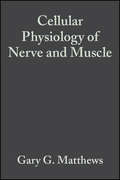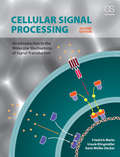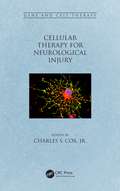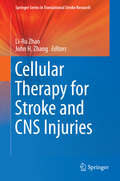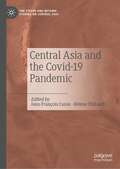- Table View
- List View
Cellular Physiology and Neurophysiology E-Book: Mosby Physiology Monograph Series (with Student Consult Online Access) (Mosby's Physiology Monograph)
by Mordecai P. Blaustein Joseph P. Kao Donald R. MattesonHelps you easily master the material in a systems-based curriculum with learning objectives, Clinical Concept boxes, highlighted key words and concepts, chapter summaries, self-study questions, and a comprehensive exam.Focuses on clinical implications with frequent examples from systems physiology, pharmacology, and pathophysiology.Provides a solid depiction of transport processes―an integral topic often treated superficially in other cell biology texts. Complete the Mosby Physiology Series! Systems-based and portable, these titles are ideal for integrated programs. White, Harrison, & Mehlmann: Endocrine and Reproductive Physiology Johnson: Gastrointestinal PhysiologyKoeppen & Stanton: Renal PhysiologyCloutier: Respiratory PhysiologyPappano & Weir: Cardiovascular Physiology Hudnall: Hematology: A Pathophysiologic Approach
Cellular Physiology of Nerve and Muscle
by Gary G. MatthewsCellular Physiology of Nerve and Muscle, Fourth Edition offers a state of the art introduction to the basic physical, electrical and chemical principles central to the function of nerve and muscle cells. The text begins with an overview of the origin of electrical membrane potential, then clearly illustrates the cellular physiology of nerve cells and muscle cells. Throughout, this new edition simplifies difficult concepts with accessible models and straightforward descriptions of experimental results. An all-new introduction to electrical signaling in the nervous system. Expanded coverage of synaptic transmission and synaptic plasticity. A quantitative overview of the electrical properties of cells. New detailed illustrations.
Cellular Primary Immunodeficiencies (Rare Diseases of the Immune System)
by Mario Milco D’Elios Cosima Tatiana Baldari Francesco AnnunziatoThis volume of the series Rare Diseases of the Immune System presents detailed state of the art knowledge on the cellular primary immunodeficiencies; it includes extensive coverage of both basic science discoveries and the latest clinical advances in the field. The book is structured in accordance with the most recent classification of PIDs and also covers updates on the T cell immunological synapse. Readers will find comprehensive, in-depth descriptions of novel cellular PID genes and related clinical applications, mucosal T cells, and the various clinical phenotypes of cellular PIDs. Cellular Primary Immunodeficiencies will be of high value for immunologists, pediatricians, rheumatologists, oncologists, internists, and infectious disease specialists and will also be informative for MD, Master and PhD students.
Cellular Senescence and Tumor Suppression
by Peter D. Adams John M. SedivyAs cells mature they naturally stop dividing and enter a period called senescence. But cellular senescence can also be induced prematurely by certain oncogenes involved in cancer development. Cellular senescence, a growth-arrest program that limits the lifespan of mammalian cells and prevents unlimited cell proliferation, is attracting considerable interest because of its links to tumor suppression.
Cellular Signal Processing: An Introduction to the Molecular Mechanisms of Signal Transduction
by Friedrich Marks Ursula Klingmüller Karin Müller-DeckerCellular Signal Processing offers a unifying view of cell signaling based on the concept that protein interactions act as sophisticated data processing networks that govern intracellular and extracellular communication. It is intended for use in signal transduction courses for undergraduate and graduate students working in biology, biochemistry, bioinformatics, and pharmacology, as well as medical students. The text is organized by three key topics central to signal transduction: the protein network, its energy supply, and its evolution. It covers all important aspects of cell signaling, ranging from prokaryotic signal transduction to neuronal signaling, and also highlights the clinical aspects of cell signaling in health and disease. This new edition includes expanded coverage of prokaryotes, as well as content on new developments in systems biology, epigenetics, redox signaling, and small, non-coding RNA signaling.
Cellular Signal Processing: An Introduction to the Molecular Mechanisms of Signal Transduction
by Friedrich Marks Ursula Klingmüller Karin Müller-DeckerCellular Signal Processing offers a unifying view of cell signaling based on the concept that protein interactions act as sophisticated data processing networks that govern intracellular and extracellular communication. It is intended for use in signal transduction courses for undergraduate and graduate students working in biology, biochemistry, bioinformatics, and pharmacology, as well as medical students. The text is organized by three key topics central to signal transduction: the protein network, its energy supply, and its evolution. It covers all important aspects of cell signaling, ranging from prokaryotic signal transduction to neuronal signaling, and also highlights the clinical aspects of cell signaling in health and disease. This new edition includes expanded coverage of prokaryotes, as well as content on new developments in systems biology, epigenetics, redox signaling, and small, non-coding RNA signaling.
Cellular Signaling in Health and Disease (Biological and Medical Physics, Biomedical Engineering)
by Martin BeckermanIn today’s world, three great classes of non-infectious diseases – the metabolic syndromes (such as type 2 diabetes and atherosclerosis), the cancers, and the neurodegenerative disorders – have risen to the fore. These diseases, all associated with increasing age of an individual, have proven to be remarkably complex and difficult to treat. This is because, in large measure, when the cellular signaling pathways responsible for maintaining homeostasis and health of the body become dysregulated, they generate equally stable disease states. As a result the body may respond positively to a drug, but only for a while and then revert back to the disease state. Cellular Signaling in Health and Disease summarizes our current understanding of these regulatory networks in the healthy and diseased states, showing which molecular components might be prime targets for drug interventions. This is accomplished by presenting models that explain in mechanistic, molecular detail how a particular part of the cellular signaling web operates properly in health and improperly in disease. The stability of the health- and disease-associated states is dynamic and supported by multiple feedback loops acting positively and negatively along with linkages between pathways. During the past few years an ongoing series of important discoveries have been made that advance our understanding of how the body works and may guide us on how to better deal with these diseases. These include the discovery of chronic inflammation as a causal factor in all of these disease classes, the appearance of reactive oxygen species as a messenger molecule that can act both positively and negatively, the propensity of proteins to misfold into aggregation- and disease-prone forms, and the rise of epigenetics including the emergence of small non-coding RNA with important regulatory functions out of the so-called junk RNA. Chapters are devoted to each of these classes of findings with additional details integrated into the chapters dealing directly with the diseases. The connections responsible for maintaining stability are explored in depth.
Cellular Therapies for Retinal Disease: A Strategic Approach
by Steven D. Schwartz Aaron Nagiel Robert LanzaThis book familiarizes the reader with the current landscape of cell-based therapies for the treatment of retinal disease, including diseases that affect the choriocapillaris, retinal pigment epithelium, photoreceptors, and retinal ganglion cells. Instead of utilizing a disease-centric approach to the topic, this book—edited by two world-renowned stem cell scientists—focuses on strategies for developing and transplanting the cells. This includes the creation of replacement cells, cell-based neuroprotection, and in vitro disease modeling and testing. The final chapters briefly review parallel approaches that do not directly utilize cellular transplantation.The use of cellular transplantation to treat retinal disease has recently become a viable and exciting therapeutic approach. The visibility of the retina and its laminar cellular architecture render it an ideal organ for the development of surgically delivered cellular therapies. Having an in-depth understanding of the current state of cell therapy for the eye is an essential first step toward utilizing similar approaches in other organs. Ophthalmologists, translational clinician-scientists, stem cell scientists, and researchers interested in eye disease will find Cellular Therapies for Retinal Disease: A Strategic Approach essential reading and it is also suitable for workshops or courses at the undergraduate or Ph.D. level.
Cellular Therapy (Ernst Schering Foundation Symposium Proceedings #20)
by H. Wekerle, H. Graf and J. D. TurnerThe use of cells for the treatment of a variety of diseases is no longer a dream. Today, blood transfusion, bone marrow transplantation, the use of ex vivo cultured skin in wound healing, and peripheral stern cell transplantation, including the ex vivo expansion of hematopoietic stern cells after high-dose chemo/radiation therapy, are routine. This high standard of knowledge and skills in cell transplantation might also re sult in tackling hitherto untreatable diseases. Organ transplantation is presently the only life-saving treatment for a variety of conditions. Important findings in cell and molecular biol ogy, the identification of hematopoietic, mesenchymal and neuronal stern cells, together with breakthroughs in the methodology for isolat ing, purifying, expanding, and storing human cells could make cellular therapy an alternative to organ transplantation in certain diseases within the next decade. Placental blood may be the source of choice in isolating naive progenitor cells for allogeneic transplantation. Immunotherapy is the most hopeful strategy to date for the treat ment of tumors resistant to chemotherapy, radiation therapy, or hor mone therapy. It includes the use of tumor-infiltrating lymphocytes, ex vivo activated memory T lymphocytes, and cell-based vaccines.
Cellular Therapy for Neurological Injury
by Charles S. CoxCellular Therapy for Neurological Injury discusses the current status of cellular therapy for neurological disorders. The primary areas of focus include traumatic brain injury, stroke (ischemic and hemorrhagic), and spinal cord injury. The book explores cell therapy approaches to these and other conditions, while discussing current advances and a l
Cellular Therapy for Stroke and CNS Injuries (Springer Series in Translational Stroke Research)
by Li-Ru Zhao John H. ZhangCellular therapy for stroke and neural trauma has gained worldwide attention during the last decade and has shown some promising results. Various cells, including neural stem cells, bone marrow stem cells, endothelial progenitor cells, and many others have had protective or regenerative effects in animal models. The proposed book will address recent research on all relevant cell types. In addition, it will provide information on cell isolation and culture skills, transplantation methods, and neurological functional evaluations. This is the first book to focus on cellular therapy for stroke and other CNS injuries.
Cellular Trafficking of Cell Stress Proteins in Health and Disease (Heat Shock Proteins #6)
by Brian Henderson and A. Graham PockleySince the beginning of the 21st Century there has been a rapid increase in our understanding of the cellular trafficking mechanisms of molecular chaperones in eukaryotes and in prokaryotes. In the former, molecular chaperone trafficking can occur between the various cellular compartments, with concomitant movement of other proteins. Such events can also result in the release of molecular chaperones from cells. In bacteria, molecular chaperones are involved in the trafficking of other proteins and are themselves released into the external milieu. The increasing appreciation of the role of molecular chaperones and Protein-Folding Catalysts in the interplay between bacteria and the cells of their hosts is now an important area of research for understanding the mechanisms of infectious diseases. This volume brings together experts in the biochemistry, cellular biology, immunology and molecular biology of molecular chaperones and Protein-Folding Catalysts with a focus on the mechanisms of cellular trafficking of these proteins and the role of these variegated trafficking mechanisms in both human and animal health and disease.
Cellulite: Pathophysiology and Treatment
by Mitchel P. Goldman Doris HexselIt is estimated that 80 percent of women have some degree of cellulite. Although there are no permanent solutions for cellulite, dermatologists recognize that this is an issue of importance for many women. This guide reviews current research on the pathophysiology and treatment of cellulite, as well as the many recent developments in medical therap
Cellulose-Based Graft Copolymers: Structure and Chemistry
by Vijay Kumar ThakurCellulose-Based Graft Copolymers: Structure and Chemistry discusses the synthesis, characterization, and properties of multifunctional cellulose-based graft copolymers. Presenting the contributions of accomplished experts in the field of natural cellulosic polymers, this authoritative text: Offers an overview of cutting-edge technical accomplishmen
Cellulose-Based Graft Copolymers: Structure and Chemistry
by Vijay Kumar ThakurCellulose-Based Graft Copolymers: Structure and Chemistry discusses the synthesis, characterization, and properties of multifunctional cellulose-based graft copolymers. Presenting the contributions of accomplished experts in the field of natural cellulosic polymers, this authoritative text: Offers an overview of cutting-edge technical accomplishmen
Cementation in Dental Implantology: An Evidence-Based Guide
by Chandur P. K. WadhwaniTreatment by means of dental implants has become increasingly common, but it is now recognized that cementation during the restorative phase can be the source of significant problems. This book examines in detail the issues associated with cementation in dental implantology, with a particular focus on residual excess cement and its consequences. It provides reliable guidance on cement selection and use on the basis of the latest scientific research. Among the topics addressed are microbial aspects of cement selection, new abutment designs, aesthetic considerations, margin placement and the role of radiography. The relation of peri-implant disease to residual excess cement is explored in depth and alternatives to the cementation process are also considered. All of the chapters have been written by leading experts in restorative and surgical dental implantology. The information supplied is guaranteed to change the way in which the dentist thinks and practices.
A Census of Greek Medical Manuscripts: From Byzantium to the Renaissance (Medicine in the Medieval Mediterranean #6)
by Alain TouwaideManuscripts containing Greek medical texts were inventoried by author and work at the beginning of the 20th century by a group of philologists under the direction of Hermann Diels. Useful as it was - and will continue to be – Diels’ catalogue omitted authors and works, misidentified manuscripts, and overlooked codices. Furthermore, since the publication of the catalogue, some libraries have adopted a new system of classification, manuscripts have been destroyed, items have changed location, and new ones have come to light. The present Census is a checklist of the Greek medical manuscripts currently known in collections worldwide. It is both an amended and updated index of Diels’ catalogue, and a list of the items missed or overlooked in Diels, or located since. Although it does not supersede Diels’ catalogue, it is the indispensable instrument for a New Diels, and will be the reference for years to come for any new critical edition and medico-historical research based on manuscripts, besides providing the basis for a broad range of other historical inquiries, from codicology to the history of medicine and science, including Byzantine intellectual history, Renaissance studies and humanism, history of the book and early printing, and the history of medical philology and learning.
A Census of Greek Medical Manuscripts: From Byzantium to the Renaissance (Medicine in the Medieval Mediterranean #6)
by Alain TouwaideManuscripts containing Greek medical texts were inventoried by author and work at the beginning of the 20th century by a group of philologists under the direction of Hermann Diels. Useful as it was - and will continue to be – Diels’ catalogue omitted authors and works, misidentified manuscripts, and overlooked codices. Furthermore, since the publication of the catalogue, some libraries have adopted a new system of classification, manuscripts have been destroyed, items have changed location, and new ones have come to light. The present Census is a checklist of the Greek medical manuscripts currently known in collections worldwide. It is both an amended and updated index of Diels’ catalogue, and a list of the items missed or overlooked in Diels, or located since. Although it does not supersede Diels’ catalogue, it is the indispensable instrument for a New Diels, and will be the reference for years to come for any new critical edition and medico-historical research based on manuscripts, besides providing the basis for a broad range of other historical inquiries, from codicology to the history of medicine and science, including Byzantine intellectual history, Renaissance studies and humanism, history of the book and early printing, and the history of medical philology and learning.
Centenarians: An Example of Positive Biology
by Calogero CarusoThis state-of-the-art review on longevity focuses on centenarians, studied as a model of positive biology. The extraordinary rise in the elderly population in developed countries underscores the importance of studies on ageing and longevity in order to decrease the medical, economic and social problems associated with the increased number of non-autonomous individuals affected by invalidating pathologies. Centenarians have reached the extreme limits of human life span. Those in relatively good health, who are able to perform their routine daily tasks, are the best examples of extreme longevity, representing selected individuals in which the appearance of major age-related diseases – including cancer and cardiovascular diseases – has been consistently delayed or avoided. The relationship between causality and chance is an open discussion topic in many disciplines. In particular, ageing, the related diseases, and longevity are difficult to define as a consequence of causality, chance or both. Discussing the relevance of these different factors in the attainment of longevity, the book gathers contributions on genetic, epigenetic and phenotypic aspects of centenarians.The “positive biology” approach is applied to clarify the causes of positive phenotypes, as well as to explain the biological mechanisms of health and well-being with the aim of preventing and/or reducing frailty and disability in the elderly.
Centenarians: A European Overview (SpringerBriefs in Aging)
by Laetitia Teixeira Lia Araújo Constança Paúl Oscar RibeiroThis book focuses on centenarians – people aged 100 and over – one of the fastest growing segments of the population in most developed countries. Drawing on official international and national data, it describes the longevity phenomenon and profiles socio-demographic, health and living conditions of long-lived people in 28 European countries. By comparing and synthesizing current information according to country, the book helps fill the knowledge gap regarding Europe’s centenarian population. Providing insights to help stakeholders better predict, plan for and respond to the challenges of extreme longevity, it is a valuable resource for students and academics in the field of population aging, gerontology and geriatrics, as well as social scientists and policymakers.
Centers for Ending: The Coming Crisis in the Care of Aged People (Caregiving: Research • Practice • Policy)
by Seymour B. SarasonAs people live longer and health care costs continue to rise and fewer doctors choose to specialize in geriatrics, how prepared is the United States to care for its sick and elderly? According to veteran psychologist Seymour Sarason’s eloquent and compelling new book, the answer is: inadequately at best. And rarely discussed among the grim statistics is the psychosocial price paid by nursing home patients, from loneliness and isolation to depression and dependency.In Centers for Ending, Dr. Sarason uses his firsthand experience as both practitioner and patient in senior facilities to reveal wide-ranging professional and moral issues affecting this seemingly familiar terrain. Insensitive medical personnel, poorly trained nurses and aides, indifferent administrators, and a prevailing culture content with treating “bodies” instead of human beings are identified as contributing factors. Drawing on America’s rich history of large-scale solutions to social problems, Dr. Sarason offers penetrating insights and bold suggestions in such areas as:The widening care gap between haves and have-nots.Why professional caregivers fail to understand patients.The nursing home resident as immigrant.Why previous reform efforts have not worked.The need for a Presidential commission for the elderly.The scenario if conditions are allowed to remain as they are or worsen.This concise volume is essential reading for researchers, graduate students, professionals, practitioners, and policy makers across such fields as geriatric medicine, health psychology, social work, public health, and public policy. Centers for Ending is a clarion call to be ignored at great cost to our elders and ourselves.
Central Asia and the Covid-19 Pandemic (The Steppe and Beyond: Studies on Central Asia)
by Jean-François Caron Hélène ThibaultThis book aims at shedding light on the reasons why the death rates during the pandemic were so high in Central Asia. More specifically, this book proposes analysis on why individuals did not follow the sanitary rules imposed by their respective government and on the role played by misinformation. Secondly, it also examines the impact of Sinophobia in Central Asia and the future challenges this feeling may pose on the authorities in the near future. Lastly, this book also proposes analysis of how the pandemic has contributed to show the inherent vulnerabilities of Kazakhstan and Kyrgyzstan by focusing on their immediate and future political consequences.
Central Auditory Pathway Disorders
by Kimitaka KagaBrain imaging and neurophysiological methods have been rapidly developed. The purpose of this book is to describe hearing problems which are caused by various kinds of brain diseases in central auditory pathway. Each topic is explained to use a lot of figures such as brain imaging and neurophysiological data comparing with neuropsychological tests. Readers will understand what happens in patients, when bilateral auditory nerve and auditory cortex are damaged in patients. Some patients can hear but cannot discriminate meanings of speech, music and environmental sounds. The author tries to explain why such a difference occurs.

